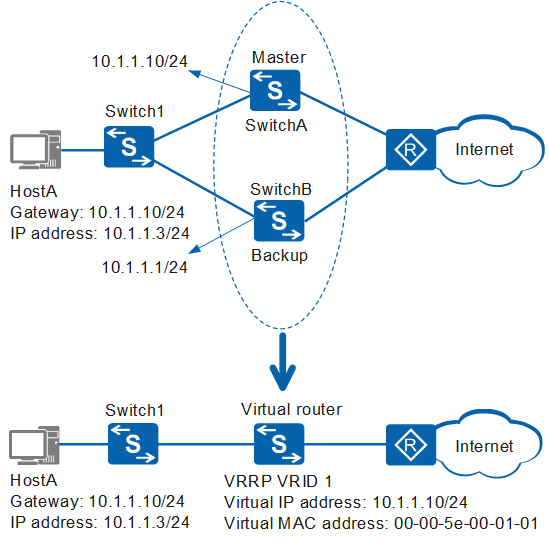Basic Concepts of VRRP
As shown in Figure 1, HostA is dual-homed to SwitchA and SwitchB through Switch1. SwitchA and SwitchB constitute a VRRP group to implement link redundancy.
As shown in Figure 1, VRRP involves the following entities:
VRRP router: The device is running VRRP.
Virtual router: VRRP group consisting of one master and multiple backups. The VRRP group's virtual IP address is used as the default gateway address on a LAN. SwitchA and SwitchB jointly form a virtual router.
Virtual router master: VRRP device that forwards packets. SwitchA is the virtual router master.
Virtual router backup: a group of VRRP devices that do not forward packets. When the master is faulty, a backup with the highest priority becomes the master. SwitchB is the virtual router backup.
VRID: virtual router ID. The VRID of the virtual router composed of SwitchA and SwitchB is 1.
Virtual IP address: IP address of a virtual router. A virtual router can be assigned one or more virtual IP addresses, which are configurable. For example, the virtual IP address of the virtual router composed of SwitchA and SwitchB is 10.1.1.10/24.
IP address owner: VRRP device that uses an IP address of a virtual router as the actual interface address. If an IP address owner is available, it usually functions as the virtual router master. The interface address of SwitchA and the IP address of the virtual router are both 10.1.1.10/24, making SwitchA the IP address owner.
Virtual MAC address: MAC address that is generated by the virtual router based on the VRID. A virtual router has one virtual MAC address and is in the format of 00-00-5E-00-01-{VRID} (VRRP for IPv4) or 00-00-5E-00-02-{VRID} (VRRP for IPv6). The virtual router sends ARP Reply packets carrying the virtual MAC address but not the interface MAC address. The VRID of the virtual router composed of SwitchA and SwitchB is 1, so the MAC address of the VRRP group is 00-00-5E-00-01-01.
